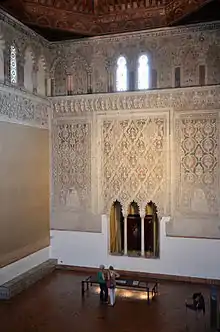Synagogue of El Tránsito
The Synagogue of El Tránsito (Spanish: Sinagoga del Tránsito), also known as the Synagogue of Samuel ha-Levi or Halevi,[1] is a historic synagogue, church, and Sephardic museum in Toledo, Spain. It was built as an annex of the palace of Samuel ha-Levi Abulafia, treasurer to King Peter of Castile, in 1357. The synagogue was converted into a church after the expulsion of the Jews from Spain in 1492.[2] It was briefly used as military barracks during the Napoleonic Wars of the early 1800s.[3] It became a museum in 1910. Today it is formally known as the Sephardi Museum.[4] The building is known for its rich stucco decoration, its Mudejar style, and its women's gallery.

History of building
.jpg.webp)
Synagogue
The synagogue was built in around 1357, under the patronage of Samuel ha-Levi Abulafia.[2] His family had served the Castilian kings for several generations and included kabbalists and Torah scholars such as Meir and Todros Abulafia, as well as another Todros Abulafia who was one of the last poets to write in the Arab-influenced style favored by Jewish poets in twelfth- and thirteenth-century Spain.[5] The synagogue was connected to Samuel ha-Levi Abulafia's house by a private gate and was intended as a private house of worship. It also served as a center for Jewish religious education, known as a yesibah[2] or a yeshiva.
Some scholars suggest that Peter of Castile assented to the construction of the synagogue as a token of appreciation for ha-Levi Abulafia’s service as councillor and treasurer to the king.[1] Peter may also have allowed it to compensate the Jews of Toledo for destruction that had occurred in 1348, during anti-Jewish pogroms that accompanied the arrival of the Black Death.
Samuel ha-Levi eventually fell out of favor with the king and was executed in 1360.[6]
Church
After the expulsion of Jews from Spain in 1492, the synagogue was converted to a church.[2] It was given to the Order of Calatrava by King Ferdinand and Queen Isabella of Spain.[5] The Order is said to have converted the building into a church serving a priory dedicated to Saint Benedict. It was from its time as a church that the building acquired the name “El Tránsito,” which refers to the Assumption of the Virgin Mary.[2] In the 17th century the church's name changed to Nuestra Señora del Tránsito: the name derives from a painting by Juan Correa de Vivar housed there which depicted the Transit of the Virgin.
Military barracks
The synagogue was used as military headquarters during the Napoleonic Wars.[3]
National monument and museum
In 1877 the building became a national monument. The transformation of the building into the Sephardi Museum, as it is now called, started around 1910. It was initiated by the Vega-Inclan Foundation.[3] In 1964, a royal decree established the Museo Sefardi, located in the Synagogue of Samuel ha-Levi.[4] Four years later, in 1968, it was renamed the National Museum for Hispanic-Hebraic Art.[4] The building, which is in a good state of conservation, remains a museum.
Restorations
Subsequent to its conversion to a Catholic church and its use as military barracks, the building underwent several periods of restoration. The first phase began in 1879 with the cleaning and repair of the hechal (Torah ark), the restoration of at least fourteen lattices, and the removal of various Hebrew inscriptions. In 1884, Arturo Mélida y Alinari replaced Francisco Isidori as the head architect of the project, focusing mainly on the roof, façade, and reinforcements. The building fell back into disrepair before it became part of the Casa Museo del Greco in 1911, when a new large-scale phase of restorations began. Scaffolding that had been put up in previous decades was removed, along with partitions from the women's gallery. The wooden church choir and portions of the interior were restored. The addition of a library to the lower part of the gallery, which has since become an important center for Hebrew studies, entailed the demolition of large portions of the façade.[3]
Architecture
With the apparent approval of the king, ha-Levi defied the laws that required synagogues to be smaller and lower than churches and plain of decoration. The prayer hall is rectangular and measures 23 × 9.5 meters (roughly 75.5 feet × 29.5 feet) and has a 12-meter-high ceiling (close to 40 feet). The prayer hall features Nasrid-style polychrome stucco-work, multifoil arches, a massive Mudéjar artesonado ceiling, Hebrew inscriptions praising the king and ha-Levi himself, Arabic inscriptions, and quotations from the Psalms. The stucco-work, arches, and ceiling were made in the style of the Nasrid palace of Alhambra. There were also Christian elements in the architecture that mixed muqarnas ornament with heraldry and vegetal motifs that were common among Christian and Islamic buildings as well as in synagogues of the time. The ornamentation also bears the ha-Levi coat of arms, a borrowing of Christian architectural customs. Arabic inscriptions surround the prayer room and are intertwined with the floral patterns in the stucco. They are in Kufic-style script and include positive devotional affirmations and praises of God common in Islamic architecture. All along the prayer hall are large larchwood frames made with inlaid carved polychrome of ivory.[7]
Women were separated from men during services; a second-floor gallery was reserved for them. The gallery is located along the southern wall, having five broad openings looking down towards the ark of the Torah (called in the Sephardic tradition the hechal, hejal, heichal or heikal). The hechal developed a design innovation in the form of a great façade that had three vertical panels with a sebka motif in the center panel,[8] as well as muqarnas cornices with vegetal and garden motifs.
The architecture of El Tránsito influenced other 14th century synagogues, like the Cordoba Synagogue, which shared the three-panel façade hechal design and the Mudéjar architecture.
Exterior architecture
In contrast with the highly ornamented interior, the exterior of the synagogue was built of brick and stone and was plain and largely unadorned. This left the synagogue an unassuming building that did not stand out from its surroundings, except in that its tall roof elevated it slightly above the adjacent buildings.[9]
 El Tránsito
El Tránsito Holy ark
Holy ark Detail of relief on ark
Detail of relief on ark.jpg.webp) The building's wooden artesonado ceiling
The building's wooden artesonado ceiling Torah ark cover
Torah ark cover Detail of the building's windows
Detail of the building's windows Coat of arms of Castile in the synagogue
Coat of arms of Castile in the synagogue
References
- Lopez Alvarez, Ana Maria; Palomero Plaza, Santiago; Alvarez Delgado, Yasmina. "Nuevos datos sobre la historia de la sinagoga del Tránsito". Sefarad. 52 (2): 473–500 – via ProQuest.
- Borras Gualis, Gonzalo; Lavado Paradinas, Pedro; Pleguezuelo Hernandez, Alfonso (2019). Mudéjar Art: Islamic Aesthetics in Christian Art. Museum Ohne Grenzen (Museum With No Frontiers). pp. 203–204. ISBN 978-3902782144.
- Ortiz Pradas, Daniel (2004-07-01). "LA RESTAURACIÓN DE LA SINAGOGA DEL TRÁNSITO". Goya. July/October 2004 (301/302): 275–288 – via EBSCOhost Art & Architecture Source.
- "Sephardic Museum of Toledo". AEJM. Retrieved 2020-12-09.
- ""El Transito" Synagogue in Toledo, Spain". Beit Hatfutsot. Retrieved 2020-12-09.
- Dodds, Jerrilynn D.; Menocal, Maria Rosa; Krasner Balbale, Abigail (2009). ""Brothers"". The Arts of Intimacy: Christians, Jews, and Muslims in the Making of Castilian Culture. New Haven, CT: Yale University Press. p. 246. ISBN 978-0300142143.
- “The Synagogue Known as El Tránsito in Toledo.” A History of Jewish-Muslim Relations: From the Origins to the Present Day 2013: 911-927.
- Muñoz-Garrido, Daniel (2020-01-12). "The Medieval Synagogue of Molina de Aragón: Architecture and Decoration". Arts. 9 (1): 9. doi:10.3390/arts9010009. ISSN 2076-0752.
- Meddeb, Abdelwahab; Stora, Benjamin, eds. (2014-01-01). A History of Jewish-Muslim Relations: From the Origins to the Present Day. Princeton University. 911 - 927. doi:10.1515/9781400849130. ISBN 978-1-4008-4913-0.
External links
- (in Spanish) Official Website
- https://www.museodelprado.es/en/the-collection/art-work/the-death-of-the-virgin/54ac6ccc-5624-421c-9c48-bb4827dc0a8c
| Wikimedia Commons has media related to Sinagoga del Transito. |

